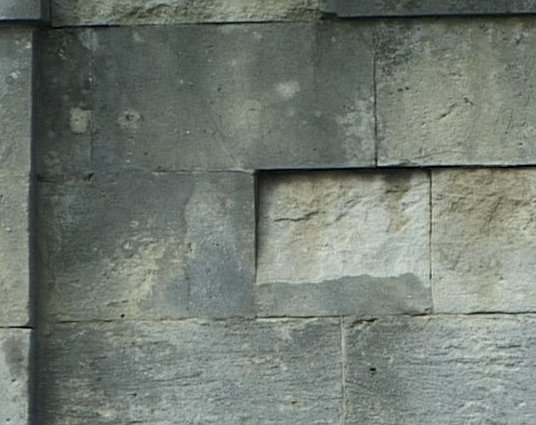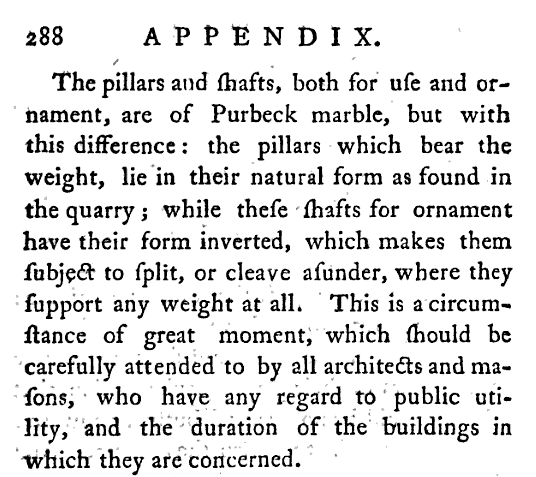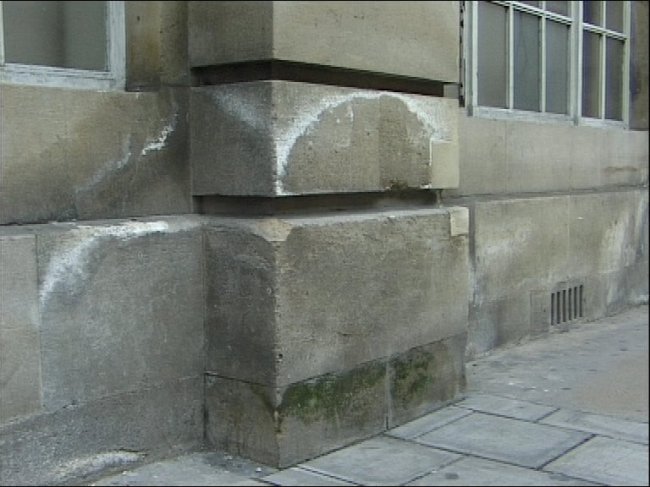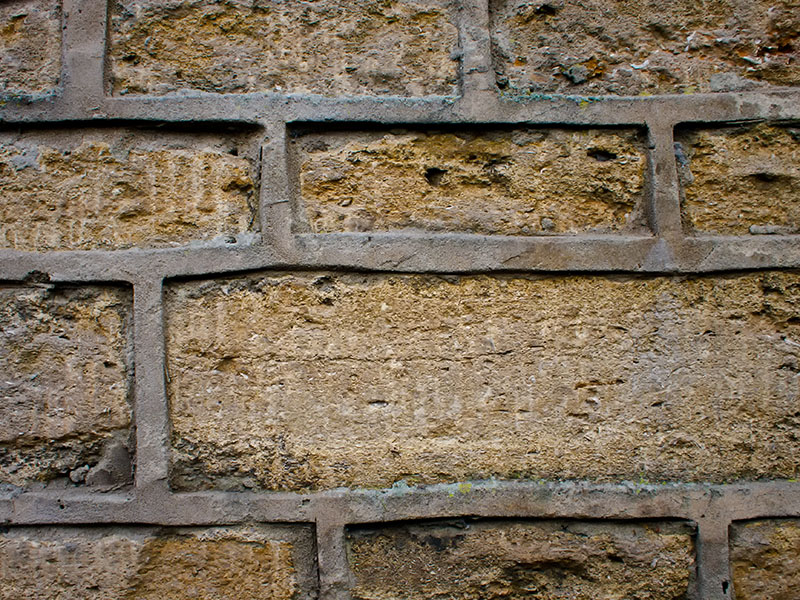Defects in stonework
[edit] Introduction
Stone is a natural but complex material. Within the general headings of sandstone and limestone there are many stone types, with different durability and weathering characteristics, and so the defects below are inevitably generalised.
[edit] Pore structure
The natural durability of stone can be affected by a number of factors; probably the most significant is pore structure. Pore structure is significant because it affects the amount of water entering and moving through the stone. Also, salts that may damage the stone can be transported by water and accumulate in the pores. The critical factor is not the total amount of space created by the pores but how they are structured.
Stones with low porosity will not allow much water penetration and are therefore less likely to suffer salt and/or frost attack. Stones with low porosity are therefore generally more durable.
Stone with high porosity will allow more water in but, if the pores are large, the water will tend to be able to evaporate reasonably quickly. However, if there is a large network of fine pores, capillary action will be high, but evaporation will be relatively low. In addition, a stone with large pores is less likely to suffer salt damage than one with small pores. This is because the larger space is more likely to be able to accommodate the expansion pressures of salt crystallisation.
[edit] Incorrect bedding
Sedimentary rocks are laid down in beds. Defects can arise if a stone block is incorrectly placed in a building in relation to its bedding plane.
When placed in a wall the stone should generally lie in its natural bedding position. This is, the layers should run horizontally, in the manner in which the stone was originally formed. The stone is stronger in this position and is also less vulnerable to defects. If the stone is face bedded (the layers are vertical), it is more vulnerable to damage through crystallisation of salts and/or frost action. This is because the mechanical actions involved find it relatively easy to push off the bedding layers as there is no restraint from the adjoining stones.
However, copings and cills are usually edge bedded because they are exposed on their top side. With a string course, the corners of a coping or carved stone, no solution will be entirely satisfactory. In theses situations attention to protective detailing will be particularly important.
The damaged stone (shown above) has been incorrectly laid. It has been face bedded and has started to delaminate. Failure occurs over time through the wetting and drying cycle, possibly exacerbated by frost attack.
The laying of stone in a face-bedded manner is not uncommon. It may have happened through ignorance of the consequence, or through difficulty in determining the layering pattern – it is easy to distinguish with some stones but less so with others.
In his 1753 book of observations on Salisbury Cathedral, architect Francis Price (Surveyor and clerk of the cathedral) wrote:
The main columns of Salisbury Cathedral are made up of several parts, all of them naturally bedded for strength. The size (height) of each stone is often determined by the depth of the stone seam. The ornamental shafts (the dark pillars), often made from Purbeck marble, a soft limestone which can be polished, are edge bedded. This is because the seams are not very deep and edge bedding allows a single shaft to be made without any joints. As Francis Prices states, this affects the strength of the shaft; if they were loadbearing, the shafts would probably split.
[edit] Salt crystallisation
This involves salts in solution passing into the stonework and entering pores of the limestone or sandstone. There are a number of salts which can cause problems and they may come from a variety of sources. Sources may include building material such as concrete, brick or mortar, as well as soil and the air. As stone dries out, salt is deposited at the surface (efflorescence) or within the stone.
Crystallisation within the pores will exert pressure, often resulting in damage. The possibility, and extent, of the damage will be related to the type of stone, the type of salt, and the characteristics of the pores – mainly their size and their arrangement.
The curved pattern staining shown above is caused by different rates of evaporation.
The potential for damage is increased because of the repetitive nature of the mechanical action caused by the cycle of re-dissolving and re-crystallising. The damage usually shows as a powdering of the surface. In some cases, it can look more dramatic by causing splits in the stone as the mechanical expansion works against an existing weakness, such as incorrect bedding or a fissure.
Because some of the salts will absorb water from the air (i.e. they are hygroscopic), they will cause damage even if there is no direct wetting from the more obvious sources such as rain, rising damp or plumbing and drainage faults. The relative humidity at which they absorb water will vary with the salt, but for some it will be below the normal level for an occupied building.
In coastal areas there will be a potent combination of salts from the seas and a high relative humidity. Also road salt can enter into the pores of stonework if the stone is at or close to pavement level.
[edit] Lime run-off
The soluble salts produced by the reaction between acid rain and the calcium carbonate in limestone can cause problems in adjacent materials. When the soluble salts are formed they may run off say, a limestone coping, onto a brick or sandstone element below. As these salts crystallise they can cause decay in materials that would otherwise not be particularly vulnerable.
For more information, see Lime run-off.
[edit] Frost attack
Frost will tend to be a problem in those areas which get both excessively wet and are subject to freezing. The vulnerable areas are described in the ‘Defects in brickwork’ article, but it is worth noting that frost damage is not very common in sheltered plain walls, except at below the damp proof course level. As with brickwork, pore structure is a significant factor in determining susceptibility to frost attack and the process of attack is the same with brickwork.
Where it does occur, frost damage can dislodge quite large pieces of stone either in vulnerable areas, such as parapets or coping, or where the stone has been damaged by other agents.
[edit] Contour scaling
Contour scaling occurs in sandstone and is thought to be the result of the pores of the stone being blocked with calcium sulfate. This seems to happen even when it is not calcareous sandstone. The effect is a breaking away of a rather thick crust from the face of the stone.
The effect produced by contour scaling resembles that caused by incorrect bedding, but it occurs irrespective of the way the bed lies. It is thought that the damage is caused by differential reaction of that part of the surface material with the blocked pores compared to the underlying body of stone when subjected to thermal and moisture movement stresses.
[edit] Expansion of metals and Wall tie failure
Iron and steel cramps have been used as fixing devices in stonework for many centuries. With these metal fixings, rust can expand and fracture the stone. Additionally, stone cavity walls may suffer from the cavity wall tie problems mention in the ‘Wall tie failure’ article.
[edit] Extraction and dressing
Stone can be damaged in the quarry if it is extracted by the use of explosives which may cause internal fractures. Damage can also be caused by excessive tooling of the surface of the stone.
[edit] Organic growths
Plants and lesser organic growth on stone are common. Sometimes they are seen as adding to the charm of stone; sometimes they are regarded as unsightly. The different perspective depends to some extent on context – thought of as detracting a classically designed building for example, or, in other situations, valued as part of the patina of age.
[edit] Lichens
Lichens are a symbiotic association of fungi and algae. They are hardy in the sense that they are able to derive sustenance from a number of sources: the fungi element seeks out water and salts and the algae element manufactures food by photosynthesis.
Lichens can produce acids which may etch into the surface of stones such as limestones or calcareous sandstones. Finely carved stonework may be particularly vulnerable. The fine rootlets of some lichens may cause minor mechanical damage. The potential for damage is reduced by the fact that lichens are extremely sensitive to air pollution.
[edit] Algae
Algae are a common form of vegetation on buildings. They prefer conditions where damp, warmth and light are available as they manufacture food by photosynthesis. They are usually green in colour, but can be red, brown or blue. Like lichens their acidic secretions can damage stone. They also collect both water and dirt and can affect the transpiration rate of walls.
[edit] Mosses
Mosses can at ‘sponges’ and retain moisture; perhaps enough in a concentrated area to cause frost attack. Like algae their presence will tend to indicate excessive dampness. They can secrete acids which may cause etching in some stones. They have also been known to develop enough to cause rot damage to very soft stones.
[edit] Fungi
Often mistaken as plants, fungi are eukaryotic organisms; they are not plants or animal. Fungi were responsible for the evolution of all plant life on earth’s land surface. Fungi can grow on stone if they can find a food source. They cannot manufacture their own food unlike plants. Fungi can produce acids and therefore possibly contribute to the decay of limestones.
[edit] Higher plants
The biological growths mentioned above could create the conditions for other plants to grow, which may be more damaging to buildings. Biological growths do this by retaining moisture and by providing humus when they die. Clearly any plant or tree could potentially seed and grow in stonework. Some may cause damage, some may not. For example:
[edit] Ivy
The roots of ivy can cause mechanical damage. Usually the damage is to mortar joints that they have lodged in, but the fine rootlets can split stone if they penetrate through crevices.
[edit] Virginia creeper
This is usually harmless as the plant merely attaches itself to the wall by suckers rather than through a root system.
[edit] Bacteria
Bacteria are thought to be able to affect decay but from a practical viewpoint the damage caused is generally insignificant. Bacteria cause damage by either staining or adding to the production of chemicals that then attack stone. An example is by oxidising sulfurous acid in polluted atmospheres thus forming sulphuric acid.
[edit] Birds and bees
Birds can damage stone (or brick) in two ways; they can cause mechanical damage by pecking for salt or grit. They can also cause decay in limestone and calcareous sandstone because their droppings release acid. Starling and pigeons are the main culprits.
Mason bees (sometimes referred to as masonry bees or mortar bees) can cause small amounts of damage as they bore into soft stone and brick to make a nest.
[edit] Acid rain
A significant cause of damage is the interaction between limestone and the products of pollution in the form of acid rain. Acid rain is produced by industrial and domestic activities and, increasingly, by road traffic. Acid rain is a generic term which includes other weather conditions, e.g. fogs, mist etc.
There is a popular impression that damage to limestone through acid rain is rather like the process involved in dissolving an antacid tablet in water. In reality, although acid rain can directly dissolve stonework, this action is relatively insignificant compared to the reaction between the acidic rainwater and the calcium carbonate in limestone.
The major problem is the production of soluble gypsum. The primary way in which this occurs is when sulphur gases go into solution with rainwater and form sulphurous acid (H2SO3). Sulfurous acid then combines with oxygen from the air. The resultant sulphuric acid reacts with the calcium carbonate (CaCO3), which is the main constituent of limestone, and forms calcium sulfate (CaSO4). The calcium sulfate takes up water and crystallises as gypsum (CaSO4·2H2O). The resulting pattern of decay of the limestone is determined, essentially, by its exposure.
- On exposed areas of the building rainwater will wash away the gypsum. Gypsum is slightly soluble in water but more soluble in acidic water or rain that contains common salt – as might be the case in a marine environment. There is a gradual weathering away of the stone, although the visual effect can, from a distance, look like cleaning or renewal.
- In sheltered areas of the building a relatively impermeable skin will start to form. The skin can be up to 12 mm thick and in polluted urban environments it will contain dirt from the atmosphere. The skin may stay in place for a long period (this might be affected by the characteristics of the particular stone), or it may form blisters that burst to reveal a powdery decayed interior. Crystallisation and re-crystallisation may also occur underneath this skin creating large areas of damage. In sheltered areas damage to magnesium sulfate will often be found forming crystals. This crystallisation often results in relatively deep caverns of decay in the stone, which are revealed when the skin breaks down. This is sometimes referred to as cavitation.
Although durable sandstones that are cemented by a quarts matrix are inert and therefore resistant to sulphur based gases, those sandstones which are cemented together by a calcium carbonate matrix (calcareous sandstones) can be severely damaged by chemical reaction with acid rain.
The reaction between the calcium carbonate and the acidic gases is the same as described above, that is, sulphurous gases in solution react with calcium carbonate to produce relatively soluble calcium sulfate. However, as in this case the cementing matrix is being attacked, it releases large amounts of otherwise stable quartz crystals. The damage is often worst than in limestone placed in a similar environment.
Dirt on stone buildings may cause problems because it can contain soluble salts. The dirt comes from particulate air pollutants which are ‘cemented’ onto a limestone wall by the gypsum produced from chemical attack. The particulates may be derived from various animal, mineral or vegetable sources but the most common are tar, diesel residue, oil, and carbon deposits.
As stated previously, the gypsum, and therefore the dirt, will be removed by rain on exposed surfaces of limestone, but it will remain on sheltered surfaces. However, with sandstone the particles become ‘bonded’ to the stone’s surfaces and will not be easily washed away by the rain.
[edit] Poor repair/conservation techniques
[edit] Incorrect pointing
As with brickwork, an inappropriate mortar mix can cause problems in both the mortar and the stone itself. The main problem is usually related to having too strong a mortar. Because a strong (dense) mortar allows less evaporation, any moisture in the wall will have to evaporate through the stone. This may increase the likelihood and severity of salt related defects.
Additionally, stronger mortars are relatively brittle and may be susceptible to shrinkage cracking. This may increase the likelihood of rain penetration, which in turn may increase the potential for salt related defects and frost attack.
An example of ribbon pointing. Shrinkage of mortar allows water penetration. The rainwater cannot shed efficiently and dense pointing impedes evaporation. In freezing conditions ice forming in joints can force pointing away from the wall.
Making the joining stand proud of the face of rubble stonework is another common mistake. This is sometimes known as ribbon pointing. Ribbon pointing is usually formed with a very strong mortar. Aesthetically, it is wrong because it is so dominant – the impression is often of a mortar wall with stone inserts. Technically, the ribbon pointing performs poorly because it shrinks and allows water ingress, it acts as a ledge for retaining water, and it is brittle and so cracks and falls away easily.
[edit] Failure of protective coatings
Coatings are often applied to stone to protect it. They are usually applied in order to:
- Prevent water penetration.
- Prevent stone decay.
Additionally, given the number of bay windows where the stonework is painted, some coatings are presumably added because they are judged to improve the look of the stone. While there may theoretically be good reason for applying a silicone based water treatment to stone (i.e. where penetrating damp is occurring), they should not be used to try to arrest the effects of stone decay. This is because the water takes longer to evaporate when a coating is applied and salt crystals are often trapped behind the treatment, causing greater damage to the stone. Eventually, the forces exerted by the salts will break down the coating.
Extensive damage can occur where bitumen based solutions are applied. Theses are a particular problem as they are very effective in preventing the stone from ‘breathing’.
[edit] Related articles on designing Buildings Wiki
- Building with structural stone.
- Choosing stone.
- Conserving Burns Monument.
- Cracking and building movement.
- Cracking in buildings.
- Defective Concrete Blocks Grant Scheme.
- Defects in brickwork.
- Defects in dot and dab.
- Efflorescence.
- Finding stone to conserve historic buildings.
- How to clean masonry.
- Kentish ragstone.
- Lime mortar.
- Lime run-off.
- Limestone for building.
- Mortar analysis for specifiers.
- Natural stone.
- Natural stone cladding.
- Natural stone tiles.
- Pattern staining and soiling in stonework.
- Penarth Alabaster.
- Portland Stone.
- Preventing wall collapse.
- Purbeck marble.
- Pyrite and mica redress issues in Dail Eireann.
- Repointing.
- Rising damp.
- Roofing defects.
- Settlement.
- Spalling.
- Stain.
- Stone consolidants.
- Tempering heating.
- Types of stone.
- Wall tie failure.
- Wimpole Gothic Tower conservation.
IHBC NewsBlog
Old Sarum fire in listed (& disputed) WW1 Hangar - Wiltshire Council has sought legal advice after fire engulfed a listed First World War hangar that was embroiled in a lengthy planning dispute.
UK Antarctic Heritage Trust launches ‘Virtual Visit’ website area
The Trust calls on people to 'Immerse yourself in our heritage – Making Antarctica Accessible'
Southend Council pledge to force Kursaal owners to maintain building
The Council has pledged to use ‘every tool in the toolbox’ if urgent repairs are not carried out.
HE’s Research Magazine publishes a major study of the heritage of England’s suburbs
The article traces the long evolution of an internal programme to research 200 years of suburban growth
IHBC Context 183 Wellbeing and Heritage published
The issue explores issues at the intersection of heritage and wellbeing.
SAVE celebrates 50 years of campaigning 1975-2025
SAVE Britain’s Heritage has announced events across the country to celebrate bringing new life to remarkable buildings.
IHBC Annual School 2025 - Shrewsbury 12-14 June
Themed Heritage in Context – Value: Plan: Change, join in-person or online.
200th Anniversary Celebration of the Modern Railway Planned
The Stockton & Darlington Railway opened on September 27, 1825.
Competence Framework Launched for Sustainability in the Built Environment
The Construction Industry Council (CIC) and the Edge have jointly published the framework.
Historic England Launches Wellbeing Strategy for Heritage
Whether through visiting, volunteering, learning or creative practice, engaging with heritage can strengthen confidence, resilience, hope and social connections.




















Comments
The photograph previously included in the article, showing 'mason bees' in fact showed honey bees.
Mason bees are solitary, making a single bee sized hole in which to provision and supply there eggs. Honey bees live in large colonies and can build a honeycomb in the wall cavity.